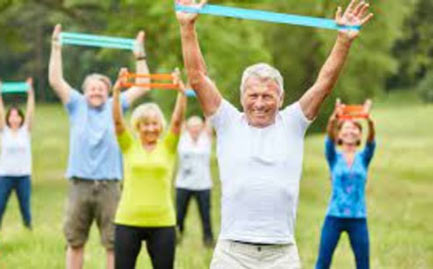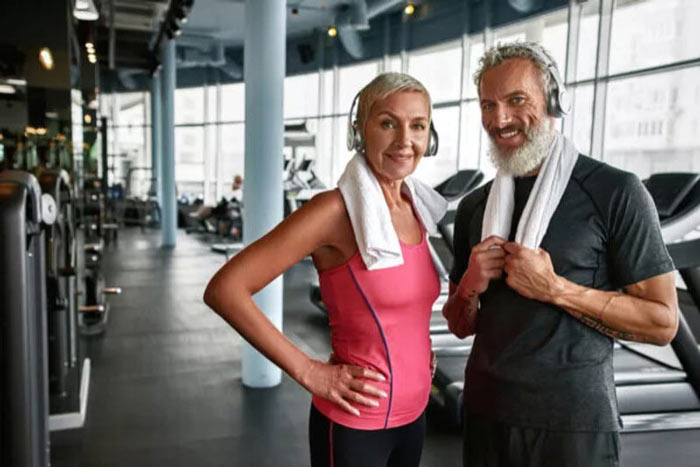Seniors must prioritize maintaining strength and stability for optimal well-being. With aging, the increasing importance of integrating a comprehensive body workout into our routines becomes evident. This article explores senior strength training, emphasizing the contribution of effective stability exercises to older adults' overall health and fitness.

Stability Exercises for Seniors
Promoting overall well-being and enhancing daily functioning in seniors necessitates essential stability exercises. Individuals can reduce the risk of falls, and improve their quality of life by concentrating on specific areas of the body to build strength and resilience.
Leg Strengthening for Stability
Maintaining stability and mobility in seniors fundamentally requires leg strength. To promote strength and balance, it is crucial to target the quadriceps, hamstrings, and calf muscles.
- Bodyweight Squats: Perform bodyweight squats to engage your quadriceps and hamstrings. Stand with feet shoulder-width apart, and lower your body into a sitting position while maintaining a straight back.
- Lunges: To work on balance and strengthen the muscles in the thighs and buttocks, incorporate lunges. Take a step forward, then, lower your body until it reaches a 90-degree angle with both knees bent.
- Leg Lifts: Target the calf muscles by focusing on leg lifts. Lift one leg at a time, whether standing or seated. Extend it straight in front of you, hold this position for a few seconds, then lower.
Core Stability for Better Balance
Seniors: a strong core serves as their foundation for enhanced balance and posture. An inclusion of routine core stability exercises, significantly enhances overall stability, thereby promoting functional independence.
- Planks: Initiate engagement of the entire core through plank exercises. Start by assuming a push-up position, arms straight, maintaining this posture ensures that there is a straight line from head to heels. Hold this position for maximum comfort and aim to strengthen your core with consistent practice and gradual lengthening of time spent in the plank.
- Seated Leg Lifts: Target the lower abdominal muscles by focusing on seated leg lifts. Situate yourself on a robust chair, extend each leg individually, and maintain it in an elevated position for several seconds before lowering.
- Russian Twists: Engage your obliques with Russian twists. Sit on the floor; then, lean back slightly, and rotate your torso to touch the ground alternately on each side.
Upper Body Strength for Functional Independence
For seniors to enhance their functional independence in daily living tasks, they must maintain upper body strength. This can be achieved by incorporating arm, shoulder, and back resistance training.
- Dumbbell Exercises: Incorporate dumbbell exercises that specifically target the biceps and triceps. For instance, start with light weights to gradually enhance strength by performing bicep curls and tricep extensions.
- Push-Ups: Enhance the strength of your chest, shoulders, and triceps through modified or wall push-ups. Execute this exercise at a comfortable angle, escalating the difficulty gradually as your muscular capacity improves.
- Resistance Band Workouts: Incorporate resistance band exercises targeting the shoulders and back, such as performing lateral raises, rows, and other dynamic movements with a quality resistance band.

Incorporating these stability exercises into a comprehensive fitness routine enables seniors to target specific muscle groups, bolster balance, and amplify overall stability. This contributes towards a healthier, more active lifestyle. Consistent performance of these crucial tasks adapted appropriately to individual fitness levels, is imperative for optimal results.
Crafting a Total Body Workout for Older Adults
Warm-up and Joint Mobility
Initiate the session with mild warm-up activities, such as brisk walking or cycling. Concurrently, incorporate joint mobility exercises into your routine to ready the body for ensuing workout intensity.
Cardiovascular Exercise for Heart Health
Incorporate low-impact cardio exercises like swimming, walking, or cycling; during each session. Strive for a minimum of 20 to 30 minutes of cardiovascular activity.
Strength Training Routine
Incorporate a blend of bodyweight exercises and light resistance training, targeting diverse muscle groups through a structured routine.
Flexibility and Stretching
Dedicate time to stretching exercises. They enhance flexibility. Specifically, consider incorporating Yoga or Pilates movements. These can prove beneficial for overall flexibility and relaxation.
Adapting the Workout to Individual Needs
Consultation with Healthcare Professionals
To ensure the safety and appropriateness of any fitness regimen for seniors, seek guidance from healthcare professionals. Before embarking on a new exercise routine, schedule an imperative consultation with your healthcare provider. This step is crucial as it allows our health team to assess your overall health. Consider pre-existing conditions, and offer personalized recommendations.
Addressing Individual Health Concerns for a Safe Workout Plan
The healthcare provider will address your specific health concerns during the consultation, and accordingly tailor the workout plan. This approach should be personalized to you and it takes into consideration factors like arthritis, cardiovascular health, and orthopedic conditions are also a key consideration.

Considering individual health aspects enables us to design a workout strategy that minimizes risks while maximizing benefits. This ensures an exercise experience that is both safe and effective.
Modifying Intensity Levels
Key to accommodating seniors' diverse fitness levels is tailoring the workout intensity. This adaptability empowers individuals, enabling them to participate in exercises that align with their current abilities, yet still present a challenge. Commence with well-tolerated exercises; then as strength and stability enhance, progressively amplify the intensity.
Gradual Progression to More Challenging Exercises
Encouraging seniors to progress at their own pace. Gradually incorporate more challenging exercises as their fitness levels advance. This approach promotes sustainability, prevents overexertion, and reduces the risk of injury.
A gradual progression not only supports physical well-being but also instills confidence, it serves as motivation for individuals to continue on their fitness journey.
Building a Healthier Future
Concluding, the Total Body Strength Workout for Seniors emphasizes stability exercises as a holistic approach to older adults' health and well-being maintenance. If seniors incorporate these exercises into their routine while adapting them to individual needs, they will experience enhanced strength, stability, and overall life quality. Embrace your journey towards a healthier future with targeted senior strength training.








